Well, befor I continue to write on this article, I would like to tell you, as to why I am writing this article.
Some of the readers from my other blog posts have questioned me asking that Kalaripayattu is the Mother of all Martial Arts, but why is it that I write so about Kuthu Varisai and Silambam as the Mother of All Martial Arts...????
BUT - BEFORE I GO ANY FURTHER, FIRST, KINDLY READ THESE TWO BLOG POSTS THAT I HAPPENED TO COME ACROSS ALMOST ACCIDENTALLY
Punch into Google Search:
ORIGINS OF KUNG FU: THE INTRICATE RREALITY BY THACHOLI NAYER
THINK AGAIN...THE MOTHER OF ALL MARTIAL ARTS BY THACHOLI NAYER
Going back to Kalaripayattu, it resembles a lot like Capoiera. This art may have been modified over the years to its present state.
In conclusion, martial arts of India today were actually the martial art of Tamil Akkam thousands of years back and not ancient India.
Some of the readers from my other blog posts have questioned me asking that Kalaripayattu is the Mother of all Martial Arts, but why is it that I write so about Kuthu Varisai and Silambam as the Mother of All Martial Arts...????
BUT - BEFORE I GO ANY FURTHER, FIRST, KINDLY READ THESE TWO BLOG POSTS THAT I HAPPENED TO COME ACROSS ALMOST ACCIDENTALLY
Punch into Google Search:
ORIGINS OF KUNG FU: THE INTRICATE RREALITY BY THACHOLI NAYER
THINK AGAIN...THE MOTHER OF ALL MARTIAL ARTS BY THACHOLI NAYER
For
a while now, many people have been hearing that martial arts had its roots in
India.
But
where in India... what art would it have been?
Some
tried to link the grappling art of Vajramushti as Kung-Fu's predesessor even though
it resembles Greek Pankration wrestling.
However,
during the 1990s the Kerala art of Kalaripayattu has came out from the dark.
Many people seeing this art with its martial arts type of kicks, punches, and
weaponry have were convinced that this must be the art which Kung-Fu has
originated from.
There
are a lot of web sites and articles stating that the art of Kalaripayattu was
the martial arts introduced by an Indian prince turned monk by the name of
Daruma Bodhidarma to China.
As
a matter of fact many have jumped to the conclusion that it was the mother all martial
arts.
Firstly,
there is no connection whatsoever between Kalaripayattu and Kung-Fu.
Kalaripayatttu was formed around the 13th century and Daruma Bodhidarma was
alive around the 6th century who traveled to China. There is a 700 year gap
between him and the formation of Kalaripayattu.
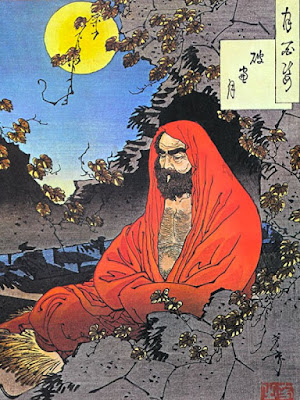 |
| Bodhidharma - The Tamil Guy: Father of Eastern Martial Arts |
Also,
Daruma Bodhidarma was born in the ancient Pallava kingdom of Kanchipuram which
is situated in the state of present day Tamil Nadu where Kalaripayattu is not a
native art of the state.
As
a matter of fact Tamil Nadu itself has several martial arts which predate
Kalaripayattu thousands of years and are even mentioned in the Tamil literature
such as the Silappadikaram during the Sangam Age of the 1st
century A.D. Another piece of Tamil literature which mentions of these martial
arts is called the Purunaruru (Four Hundreds songs on War and Wisdom)written
around 500 B.C.E.
Another thing I would like to point out is that India was not in existence before the arrival of the British around the 1600s. It was the British who unified the states and other regions into India along with Burma and Pakistan.
Another thing I would like to point out is that India was not in existence before the arrival of the British around the 1600s. It was the British who unified the states and other regions into India along with Burma and Pakistan.
Before
the British, the Indian sub-continent consisted of many countries and kingdoms.
The latest parts of the sub-continent to be brought into the Indian Union were
the 5 French territories of Pondicherry in 1956.
Before
that, it was Assam, Manipur, and the other Eastern states which came under the
British rule and became part of their India during the late 1800s which can be
found at Thang Ta: Martial Art of Manipur.
At
one time the states of Kerala, Tamil Nadu, and even parts of Sri Lanka were
originally called Tamil Akkam. It was one Tamil administration with three
major dynasties being the Pandyan, Cholas, and the Cheras. The Pallavas were
also part of Tamil Akkam at one time.
However,
their empire was divided by Tamil Nadu and Andra Pradesh. The land where the
Cheras ruled later came to be known as Kerala where they formed their own
language out of Tamil called Malayalam.
Till
1956, Kerala was under the rule of Tamils. Kerala was NEVER a separate state
until 1956.
The
Malayalam language spoken in Kerala today, was derived from Tamil, with a
mixture of Sankrit.
BUT
– Until, 1956, befor Kerala became a separate state, the Malayalam language or
the Language of North Kerala (from Malappuram to Kadathanadu) was known as
Malabar Tamoul (actually Tamil, but pronounced as Tamoul).
The
name Kerala comes from the term Chera, Kingdom. The Chera Kingdom was a Tamil
Kingdom, ruled by the Tamil Kings who had the title “Perumal”.
During
the Portuguese Invasion, the Portuguese called the place Kera, as they
pronounce the Ch sound as in Bach
i.e., with a K sound; and La
means “The” in Old Portuguese.
This
is how Cherala, became the term “Kerala”.
SO,
IT IS EVIDENT THAT KERALA OR MALAYALAM DID NOT EXIST TILL THE NOVEMBER 1956.
As
a matter of Fact, the Keralites are originally Tamils only.
Only
the Namboothiris are the Aryan Invaders to the Tamil Chera Kingdom.
The
original inhabitants of the Chera Kingdom are the Ezhavas.
The
Ezhavas were the rulers of the Tamil Chera Kingdom, NOT the Thiyyas.
Though
Thiyyas are the Northern counterpart of the Ezhavas, they DO NOT like to be
identified with the Ezhavas.
Ezhavas
are Sri Lankan Tamils. In Tamil Eelam means Sri Lanka and Ezhava means Sri
lankan.
It
were the Cholas who took captives and slaves from places where they conquered
in India and abroad, and placed those slaves in Sri Lanka.
Formerly,
Sri Lanka was known as Thamaraparani, after the name of River Thamaraparani in
Tirunelveli district of Tamil Nadu, which belongs to the Pandiyas.
Tenkasi
Pattinam of Tirunelveli district was the Fromer Capital of The Pandiyan
Kingdom, before Madurai became the Capital of the Pandiyas.
These
slaves who were kept in Thamaraparani (Today’s Sri Lanka) later got mixed with
each other to form a new community called Sinhalese.
Before
these Sinhalese were formed, the Ezhavas were the original inhabitants of
Thamaraparani.
Ezhavas
of today’s Kerala and the Nadars of Tamil Nadu are actually Niece and Nephews.
While
the Nadars were the rulers of the Pandiyan Kingdom, The Ezhavas were the rulers
of The Tamil Chera Kingdom.
Ezhavas
were great Archers. This is the reason why the Symbol of the Tamil Chera
Kingdom was Bow & Arrow, representing the mighty skilled Archers.
Punch into Google Search:
As
a Matter of fact, Tamil Akkam had such a powerful army and navy in Southern
India and Sri Lanka, that not even the Mauryan Empire of Asoka could over power
it.
It
is amazing how Emperor Asoka was able to conquer from North India to Pakistan, Afghanistan
and much of central India, but could not conquer Tamil Akkam!
This
was probably due to their martial expertise as well.
Much
information can be found along with a map of the Mauryan Empire of Asoka in K.A. Nilakanta Sastri's Age of
the Nandas and Mauryas.
Another good book to read on this would be Asoka and the Decline of the Mauryas by Romlia Thapar. Here is a link to the map of the extent of Asoka's Empire
 |
| Mauryan Empire of Ashoka the Great - who could NOT touch the borders of Ancient Tamil Akkan |
Going back to Kalaripayattu, it resembles a lot like Capoiera. This art may have been modified over the years to its present state.
As
for the Martial Arts of Tamil Nadu and Northern Sri Lanka, they are called
Kuttu Varisai (empty hand combat), Varma Kalai (pressure point study), and an
array of weapons arts.
 |
| Kuthu Varisai - The Mother of Chinese Kung Fu and Japanese Karate Jutsu |
Kuttu
Varisai resembles a mix of both Karate and Kung Fu having its own animal forms
too.
 |
| Kuthu Varisai - Animal Styles |
There is one stance in Kuttu Varisai which resembles the horse stance which is found in Kung Fu and Karate. However, it is called the Bear stance.
There are many weapons arts and each weapon is a mastery of its own. One of the
most famous one is called Silambam which is similar to the Bo staff fighting in
Japan. There are a total of 96 Katas for this art.
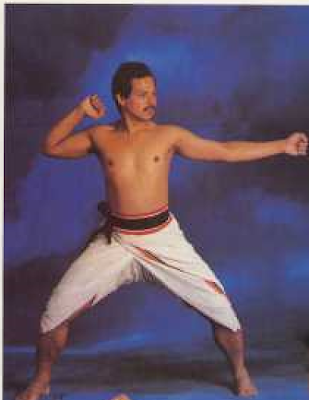 |
| Bear Stance of Kuthu Varisai |
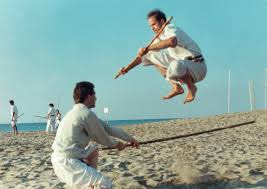 |
| Silambam, Martial Art of Tamils |
Another
weapon is the Erathai or the double stick similar to the Filipino Kali or
Sinawali.
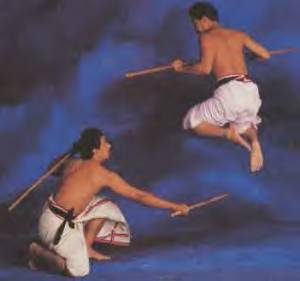 |
| Erathai Silambam |
There
are two unique weapons which are not found outside of Southern India which is
the Surul Pattai (steel blade whip) and the Madhu (deer horns).
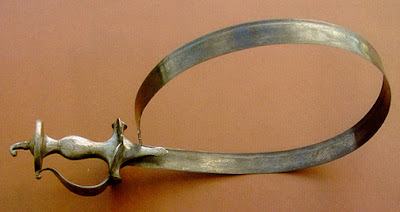 |
| Spring Sword with 1 Blade |
 |
| Spring Swords with 2 and 3 Blades |
 |
| Deer Horn - A unique weapon os Silambam, Martial Art of Tamils |
Other
weapons arts of the Tamil country are the Val Vitchi (single sword) and the
Eretthai Val (double short sword).
| VaaL Veechu of Silambam, Martial Art of tamils |
Between the 2nd to 12th century AD the Pallavas and the Cholas have done
intensive sea trade with Southeast Asian kingdoms like that of Angkor
(Cambodia), Sri Vijaya (Indonesia) and even as far as China.
It
is possible that the Pallavas may have had contact with Japan during their
seafaring naval expeditions. A good source on that would be in the book titled
Traditional
Cultural Link between India and Japan (During the 8th and 9th centuries) written
by Dr. Kalpakam Sankarnaryan and Dr. Motohiro Yoritomi.
There is a
possibility the inhabitants of the islands of Japan may have adopted certain
forms of Kuttu Varisai and Silambam by the Pallavas. Silambam which might be
precursors to Kendo, Ken-Jutso, and Karate.
Much information can be got from the Monthly Magazine of France titled
"La Varma Kalai: L'Origin du Karate - Master Zacria Rahama"
During the Chola Empires zenith between the 10th and 12th centuries they had conquered much of Southern India and Eastern parts going through Manipur, Assam, and Southern Burma. There empire stretched to as far south as Sri Lanka & Maldives, and to the East was Sumatra, Java, and Malaysia (Kadaram).
During the Chola Empires zenith between the 10th and 12th centuries they had conquered much of Southern India and Eastern parts going through Manipur, Assam, and Southern Burma. There empire stretched to as far south as Sri Lanka & Maldives, and to the East was Sumatra, Java, and Malaysia (Kadaram).
Their
martial arts must have been one of their exports along with various other arts
like dance, architecture, and the Tamil version of the Ramayana.
The Ramayana (or
Ramayanan, Ramavataram) was re-written from Sanskrit to Tamil by the sage
Kavicakravarti Kamban of the 9th century A.D. of the Chola kingdom of Tanjore,
Tamil Nadu.
There
are certain moves which are in Muay Thai which are called the Hanuman or Lim
Lom. Hanuman was a warrior in the Ramayana epic. Three sources on this can be
found in
Cholas by
K.A. Nilakanta Sastri,
Mystery of the Maldives by
Thor Heyerdahl,
and
Muay Thai: The Most Distinguished Art
of Fighting written by Panya Kraithat and Pitisuk
Kraitus.
As for the Shaolin, it may be possible that Daruma Bodhidarma did go there and introduced Dhyan [Zen (in Japanese), Chan (in Chinese)].
As for the Shaolin, it may be possible that Daruma Bodhidarma did go there and introduced Dhyan [Zen (in Japanese), Chan (in Chinese)].
The
absence of fighting forms in China before Daruma Bodhidarma is absolutely
false.
If
there was no fighting form in China, then how did there armies fight which most
definitely predates the arrival of Daruma Bodhidarma?
There
were fighting forms in China.
It
was Daruma Bodhidarma who introduced his concept of breathing exercises, the
arts of the vital points and the 18 Lohan which can be seen in Kuttu Varisai of
present day Tamil Nadu.
His
introduction of these Dravidian combat forms and exercises was adopted by the
Chinese which later evolved into Kung - Fu. However, Bodhidarma was also not
the only Sage who went to China.
There was another Tamil sage who travelled to China well before him around the 5th century B.C. by the name of Boghar Siddha. He was accompanied by Lao Tse the founder of Taosim and who was the first Chinese to propound the theory of duality of matter -- the male Yang and female Yin -- which conforms to the Siddha concept of Shiva - Shakti or positive-negative forces.
There was another Tamil sage who travelled to China well before him around the 5th century B.C. by the name of Boghar Siddha. He was accompanied by Lao Tse the founder of Taosim and who was the first Chinese to propound the theory of duality of matter -- the male Yang and female Yin -- which conforms to the Siddha concept of Shiva - Shakti or positive-negative forces.
In
Tamil, Yin and Yang translates to Idai Nadi (female, moon) and Pingelai Nadi
(male, sun).
The
unification of the two becomes Lingam which is a symbol of Siva. The Sanskrit
adaptation of the Yin and Yang is Shiv and Shakt (or Siva and Shakti). The
Sanskrit translation of the unification of Shiv and Shakt is called Prana.
Prana
is "breath" and is understood as the vital, life-sustaining force of
living beings and the vital energy in all natural processes of the universe.
Acupuncture from Tamil Akkam was also introduced to parts of Asia. This was called Varma Cuttiram also known as Varma Kalai. Originally formed as a medicinal healing art, this can also be used to maim and even kill people. Arts in China which relate to the Varma arts are Tai Chi and Dim Mak.
Acupuncture from Tamil Akkam was also introduced to parts of Asia. This was called Varma Cuttiram also known as Varma Kalai. Originally formed as a medicinal healing art, this can also be used to maim and even kill people. Arts in China which relate to the Varma arts are Tai Chi and Dim Mak.
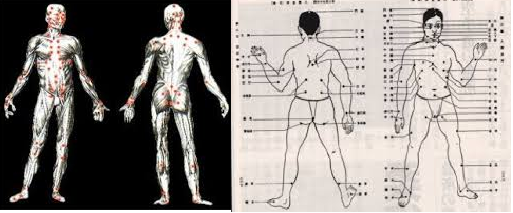 |
| Varma Kalai, Tamil Nadu (Left) Dim Mak, China (Right) |
In Southeast Asia the arts of Krabi Krabong in Thailand and Silat in Indonesia
bear a lot of resemblances of the Silambam and Kuthu Varisai warfare arts of the
Tamils. The animalistic styles and even forms of animism found in Silat are
also found in Kuttu Varisai where invokes a specific animal spirit or energy
into ones body.
Many
Chola and Pallava Naval and Merchant ships landing in parts of Southeast Asia
have not only brought with them the Hindu and Buddhist religions, but the
martial arts as well which fused with the indigenous fighting styles of
Southeast Asia.
Source:
Tamil Merchant Guild in
Sumatra written
by K.A. Nilakanta Sastri.
In the Bible in the book of Solomon and Esther it mentions about trade and contact with India. The term India was used in the King James Version which was translated from Hebrew and Greek during the 1600s and the rise of the British Empire.
In the Bible in the book of Solomon and Esther it mentions about trade and contact with India. The term India was used in the King James Version which was translated from Hebrew and Greek during the 1600s and the rise of the British Empire.
The
King James came about after the British took control over many kingdoms and
countries forming it into one British Administration and giving the name India.
India
is actually a Latin word for Indo or Indus in Greek which is Hindu in the
Persian language of Farsi near Iran and Pakistan.
In
the Tamil texts it mentions about King Solomon’s trade and contact with the
Chera, Pandya, and Chola kingdoms of Tamil Akkam. King Solomon was not the only
one in contact with the Dravidian kingdoms but Rome, Greece, and Egypt. This
information can be found in
Foreign Notices of South India: from
Megasthenes to Ma Huan written by K.A. Nilakanta Sastri.
Other
than spices, precious stones, silk, and exotic animals being exported to Rome,
Greece and the Middle East, weapons and fighting styles were exported as well.
The
Romans and the Greeks who traveled to Tamil Akkam were known by the ancient
Tamils as the Yavanas.
Weapons
like the trident amongst others were imported to Rome including certain
fighting forms which were used in gladiatorial fights in Rome. More information
can be found in
Silambam fencing from India by
Manuel J. Raj and
The Commerce Between the Roman Empire
and India by E.H. Warmington.
There are even older fighting styles of the Tamils which may have found its way through the Indian sub-continent and from Australia.
There are even older fighting styles of the Tamils which may have found its way through the Indian sub-continent and from Australia.
These
are known as Dambe of Nigeria which one hand is bound for punching, and kicking
and head butting are allowed.
Similar
arts to Adithadi of Tamils are Dambe Boxing of Nigeria, and Muay Thai of
Thailand.
 |
| Adithadi - Martial Art of Tamils |
The
Ringa Wrestling of Madagascar is similar to the Tamil Wrestling called Marpor
or Malyutham.
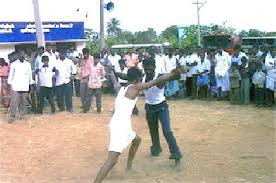 |
| Malyutham - Traditional Wrestling Sport of Tamils |
Amongst
the many fighting styles and sports of Africa is the Savika bull fight which
can also seen in the Tamil Nadu and parts of Northeastern Sri Lanka bull fights
known as Jalli Kattu.
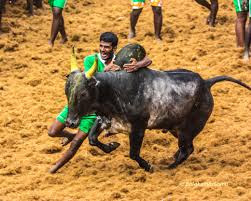 |
| Jalli Kattu |
Ancient
Tamil texts mention of an ancient land mass connecting India with Australia and
Madagascar. It also mentions names of cities and rivers which lie beneath the
Indian Ocean today.
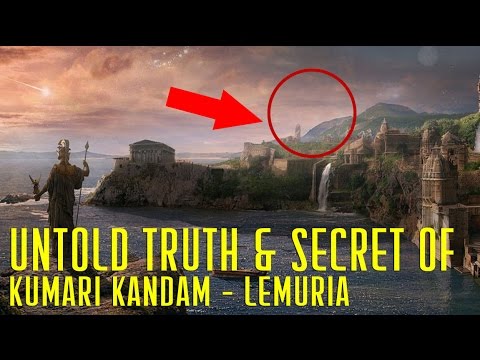 |
| Kumari Kandam |
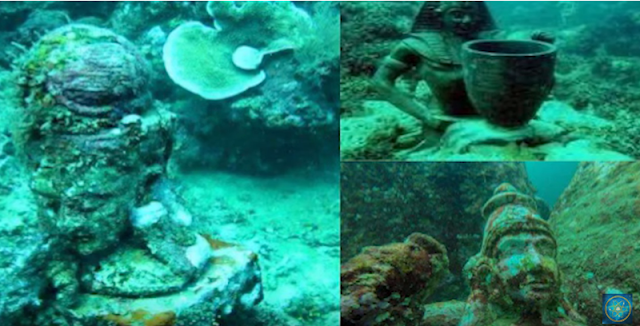 |
| Inside the Indian Ocean - Kumari Kandam remains |
The
Indian sub-continent and Australia both lay on the same tectonic plate called
the Indo-Australian plate. The tsunami of December 2004 also
proved the Lemurian theory when it washed back a couple of miles
exposing temples and artifacts in the Bay of Bengal near Mammalapuram, Tamil
Nadu. That was the fourth tsunami recorded in the history of South Asia. The
third was during the early 1900s.
In
the Tamil Silappadikaram it also mentions of a great flood or
tsunami which wiped out an ancient Pandyan city. An interesting book which goes
into detail is called
The Lost Land of Lemuria: Fabulous
Geographies by Sumathi Ramaswamy
The
resemblances between Tamils, Malayalees, Australian aborigines and East African
are very close. There is an ancient weapon that was used in Tamil Akkam called
the Valari which resembles the Boomerang of Australia. The Valari was shaped
like the boomerang, but was tipped with a metal blade. Here is an article
written by Dr. S. Jayabarathi Jaybee on the Valari
Weapon
 |
| VaLari - The Boomerang of Tamil Nadu |
In conclusion, martial arts of India today were actually the martial art of Tamil Akkam thousands of years back and not ancient India.
India
or the Indian Union did not come into play until after the arrival of the
British around the 1600s.
Kalari
Payat is a very dynamic martial art with an array of weaponry including
pressure point attacks and massage. However, it does not go any further back
than the 13th century as quoted from
Phillip Zarilli's When the Body Becomes All Eyes: Paradigms,
Discourses and Practices of Power in Kalarippayattu, a South Indian Martial Art .
Daruma
Bodhidarma was also well alive almost 700 hundred years before the formation of
Kalaripayattu. There were also many other sages and monks who have travelled
from present day Southern India to China well before Daruma Bodhidarma.
Here are some related links:
Lost city found off Indian coast
Tsunami throws up India relics
Varma Kalai martial art of Tamil Nadu
Silambam (staff fighting) of Tamil Nadu
Kalairpayattu martial art of Kerala
Here are some related links:
Lost city found off Indian coast
Tsunami throws up India relics
Varma Kalai martial art of Tamil Nadu
Silambam (staff fighting) of Tamil Nadu
Kalairpayattu martial art of Kerala
BENJAMIN FURROWS
No comments:
Post a Comment